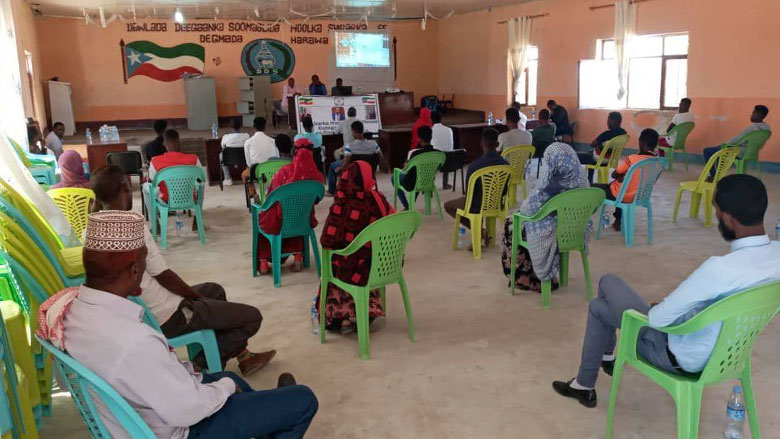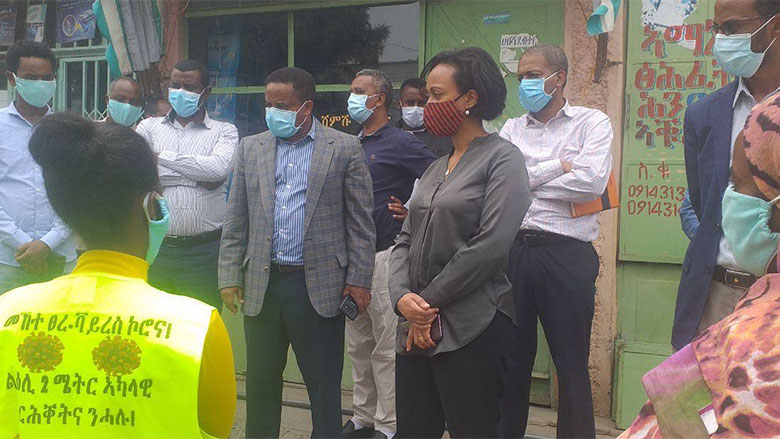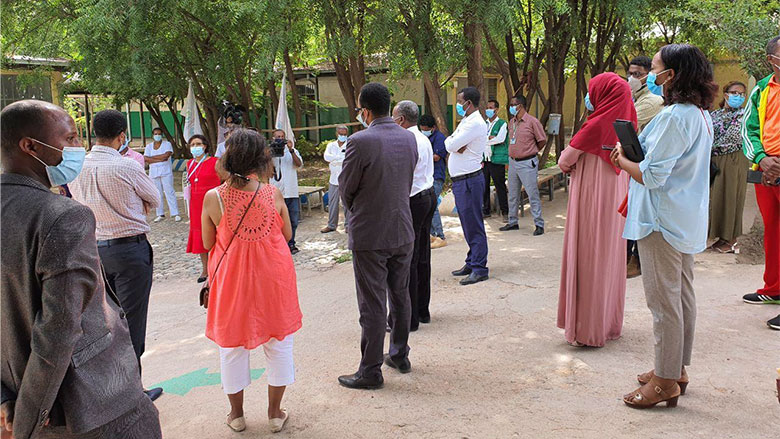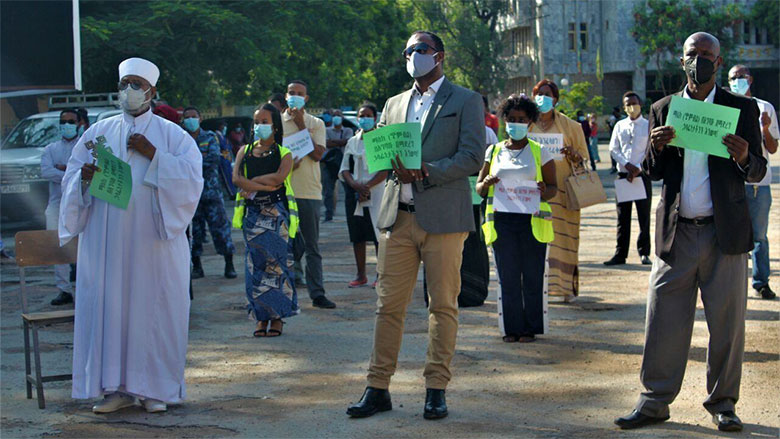Challenge
The COVID-19 outbreak occurred alongside political unrest and other public health emergencies in Ethiopia. The Ministry of Health and the Ethiopia Public Health Institute developed an Emergency Preparedness and Response Plan (EPRP) for the pandemic. The plan aims to strengthen the surveillance system and response capacity to early detect and respond to the possible importation of an outbreak. To help contain the spread of the virus, the government declared a State of Emergency on April 8, 2020. It introduced measures such as a nationwide ban on gatherings of more than four people, making the wearing of masks compulsory outdoors, and regulating the operation of transportation services, hotels, and restaurants under reduced capacity. While the preparedness for the outbreak response was continuing, there was limited capacity in analyzing how the epidemic would progress from that single case identified in March 2020 to understanding the evolving nature of the pandemic, and in testing (on average 5,000 tests per day by May 2020 for more than a million people).
Approach
The Ethiopia COVID-19 Emergency Response Project was prepared during a 10-day period in early March 2020. The objective was to fill critical gaps in implementing the EPRP and strengthen the prevention activities, rapid detection, preparedness and response to the COVID-19 outbreak.
The emergency response relied on the country’s prevention-based primary public health-care infrastructure and the health extension system built during the last two decades, community mobilization, and public-awareness campaigns.
Through the project, the government swiftly adopted public measures to contain the spread of the pandemic in the Ethiopian territory. Since March 2020, authorities have done the following: implemented surveillance at borders and conducted contact tracing; established designated quarantine facilities in each region and new temporary isolation rooms in selected hospitals; disseminated health education materials across the country, and conducted a door-to-door communication effort in Addis Ababa; and ensured the supply of drugs and protective equipment for case management and infection prevention, as well as laboratory equipment, reagents, and consumable supplies.

Results
Since June 2020, the number of identified COVID-19 cases has increased substantially in Ethiopia, due to both expansion of community transmission (as anticipated by epidemiological models), as well as significant improvements in testing capacity for detection. In response, the government has a new and innovative approach, the Enhanced Community Mobilization Activities and Testing, tailored to address the immediate needs of the current phase of the epidemic in the country, while continuing to apply an integrated Whole of Government Approach (coordinated, consistent, and enforced State of Emergency). One of the key strategic shifts in the new approach has been the introduction of community/self-isolation sites within households, with health professionals closely following up to mitigate socioeconomic consequences of COVID-19 on vulnerable groups.
Results achieved with support of the project:
- Laboratory and testing capacity - Since early February 2020, national capacity of confirmatory testing has increased substantially, from no in-country capacity at the start of the project to currently approximately 69 functional labs with COVID-19 testing capacity across all regions. Daily testing capacity increased to an average of 20,000. As of September 17, 1,176,252 tests had been conducted, with a total of 66,913 confirmed positive cases.
- Screening at Points of Entry – Travelers’ health screening has been instituted at points of entries. Health screening of passengers for COVID-19 at international airports and designated ground crossings has been underway since January 24. Currently, there are 27 active passengers screening points in the country.
- Isolation, quarantine, and treatment centers - As of June 15, 332 isolation, 50 quarantine, and 64 treatment centers had been established providing services. Mandatory quarantine of passengers coming to Ethiopia at designated hotels and quarantine centers has been in place since March 23, 2020. The Millennium Hall (exhibition center) has been converted into a COVID-19 isolation and treatment center with about 1,000 bed capacity.
- Surveillance and contact-tracing: Toll-free call centers are up and running 24 hours a day, seven days a week, at the national and subnational levels, with an average of 8,000-10,000 calls being responded to daily. Contact tracing and follow-up with persons who had contact with confirmed cases are ongoing. Home-based quarantine is being implemented for contacts of confirmed cases, accompanied by laboratory testing and follow-ups by health professionals.
- Communication: A Risk Communication and Community Engagement Strategy has been developed, and dissemination of messages has commenced. This includes the insertion of a recording at the beginning of all phone calls with information on how to prevent the coronavirus, what the symptoms are, and telephone number to call if care is needed.
World Bank Group Contribution
The $82.6 million International Development Association (IDA) financing, under the COVID-19 Fast Track Facility Multiphase Programmatic Approach, aims to fill critical gaps in the health sector within the government’s national response efforts. The World Bank’s contribution is 54 percent from the mobilized resources so far. The project is also complemented by the Pandemic Emergency Financing, $7.2 million, focusing on surge capacity building.
The project design includes mechanisms for fund flows and expenditures to remain as flexible as possible, and fit-for-purpose to respond to emerging health needs as the epidemiological situation evolves in Ethiopia.

Partners
There is a strong partnership among key development partners in Ethiopia’s health sector, including recent COVID-19 response efforts. Since the first case in early March 2020, the Ministry of Health and the Health Partners Network (the coordination and communication mechanism for key donors and development partners in the health sector) organize biweekly meetings to provide updates on COVID-19 response activities, epidemiological profile and evolution, and impacts within the health sector for non-COVID specific essential health services. The Ministry of Health put together a resource mapping database, which is regularly shared during the meetings to provide core information on resource mobilizations/contributions from partners to avoid unnecessary duplications.
Moving Forward
As the World Bank prepares for a second round of financing to the Global Multiphase Programmatic Approach for the COVID-19 Fast Track Facility, several key areas should be considered for further discussion and decision:
- Additional needs for strengthening disease surveillance, preparedness, response and containment systems and mechanisms; treatment measures to be included given the current situation in the country; and future projections and anticipated needs.
- Things to consider at the country level in preparation of vaccine availability.
- Measures aimed at ensuring the continuity of public health services, documenting what has worked and what has not worked so far; expanding healthcare coverage; and ensuring shielding and inclusion of refugees, and vulnerable population groups.

Beneficiaries
A very happy ending to a truly distressing story.
Mrs. Radia Shigute is a resident of Adama, one of the urban districts in western Ethiopia. Considering the increase in transmission of COVID-19, Mrs. Radia’s family strictly adheres to all precautionary measures of the government like regular hand washing, maintaining social distancing and wearing face mask when going outdoors to stop the transmission of the pandemic. Mrs. Radia’s chronic allergy (sinusitis) forced her to visit a health facility and while there, she got tested for the virus and had a positive viral test for COVID-19. She was so ecstatic thinking she was free from the virus when she didn’t receive a phone call from the health facility within 24 hours. Nevertheless, her joy did not last for long. Her phone rang early in the morning while she was getting prepared to make her daily spiritual practice. The person on the other end informed Mrs. Radia about the test result, the associated risks, and advised her what she needed to do to stop the transmission of the virus to the rest of the family and the community at large. Taking this opportunity, the assigned health professional explained to the family that the virus could happen to anyone with no symptom and the negative effects it has on health. In doing so, the health professional increased the family’s awareness of COVID-19, particularly on the asymptomatic cases. To Mrs. Radia’s surprise, she was asymptomatic the whole time. She did not develop any illness and recovered without hospitalization. Based on the health professional’s advice, Radia had fulfilled all the requirements to stop the transmission of the virus to her immediate family. The rest of the family tested negative. Mrs. Radia’s whole journey as a COVID-19 patient was without symptoms, but isolating herself in a confined room and thinking of the final test result was the toughest experience. For every traumatic experience, there is a possible happy ending.
